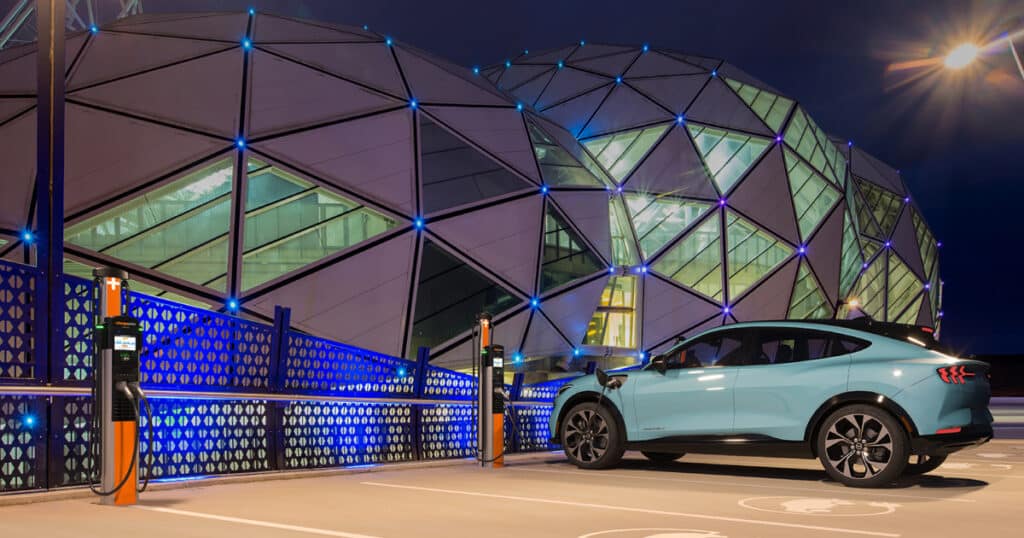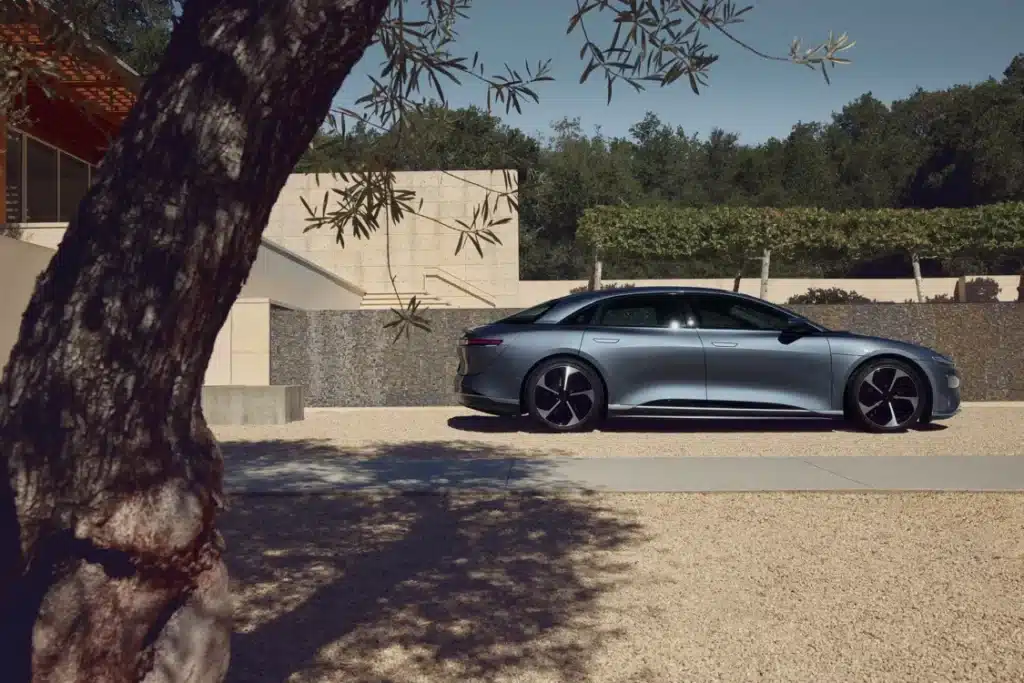ChargePoint Highlights New EV Charging Trends and Technologies Shaping the Future
On September 26, 2024, ChargePoint, a prominent provider of networked charging solutions for electric vehicles (EVs), announced key trends it believes will drive the growth of EV charging in the coming years. The company is actively working across various market segments and vehicle classifications, aiming to maintain its leadership in charging innovation. ChargePoint is focused on developing cutting-edge products that cater to the evolving needs of the future EV ecosystem.
“The charging industry routinely discusses the ‘now,’ without saying much about the future,” said Rick Wilmer, CEO of ChargePoint. “ChargePoint remains focused on the opportunities ahead of us. Innovations that previously seemed futuristic are about to materialize, so we are excited to relay the trends and technologies that we believe will disrupt EV charging as we know it.”

V2X is the Future of the Grid and EV Charging
ChargePoint highlighted that significant advancements in EV charging are on the horizon, driven by next-generation products and features. The most transformative developments are expected in the innovative software behind the charging infrastructure, which will, in turn, revolutionize the hardware. Additionally, both chargers and vehicles are evolving toward V2X (vehicle-to-everything) capabilities, which will allow vehicles to interact with the grid and other systems.
These advancements are anticipated to reshape the economics of home, fleet, and municipal charging by improving efficiency and balancing the electrical grid. Automotive manufacturers are increasingly recognizing the importance of embracing charging technologies to boost vehicle sales and enhance the customer experience.
The vehicle-grid integration (VGI) landscape is at a pivotal moment, as the increasing number of electric vehicles (EVs) connected to the grid creates both significant opportunities and complex technical challenges. At the heart of this shift is the evolving role of EVs as dynamic grid resources, where they do more than just consume electricity. With V2G (vehicle-to-grid) and V2X (vehicle-to-everything) technologies, EVs are now positioned to store, manage, and even supply energy back to the grid. The Vehicle-Grid Integration Council (VGIC) is a top authority in the VGI space, addressing these concerns.
Hosted by the Vehicle-Grid Integration Council (VGIC), EVolve 2024 is the industry’s leading VGI event. The event is set to take place on October 9, 2024, in Berkeley, CA. This event offers a unique opportunity to engage with thought leaders and technical experts from the transportation electrification, utility, and fleet sectors. Attendees will explore cutting-edge innovations and developments shaping the future of Vehicle-Grid Integration (VGI), a critical component in advancing sustainable and efficient transportation and energy systems.
A leading company in the V2G space is Nuvve Holding Corp, which is at the forefront of global electrification, starting with the transportation sector, leveraging its intelligent energy platform. The company is recognized for its advanced vehicle-to-grid (V2G) technology, which allows electric vehicles (EVs) to interact dynamically with the grid. By partnering with an ecosystem of electrification stakeholders, Nuvve optimizes power management between EV batteries and the grid.
Nuvve’s platform transforms EVs into mobile energy storage assets, integrating battery capacity to meet fluctuating energy demands and making the grid more resilient. This approach promotes sustainable transportation while supporting energy equity in an increasingly electrified world. Since its founding in 2010, Nuvve has deployed V2G technology across five continents and offers comprehensive electrification solutions for all types of fleets. The company is headquartered in San Diego, California, home of EVinfo.net.
In the video interview below, Nuvve CEO Gregory Poilasne and Thomas Dulin, Director of Transit Systems for the Fresno Economic Opportunities Commission (Fresno EOC), discuss the transformative potential of Vehicle-to-Grid (V2G) technology in public transportation. They highlight how Nuvve’s recent V2G project in Fresno is positioned to revolutionize transit systems by enabling buses and other vehicles to serve as energy storage units that can supply power back to the grid.
Lucid Leads Range Increases, EV Charging Speed is Increasing
Automotive manufacturers have recognized that fully embracing charging infrastructure is essential for driving EV sales and ensuring a seamless customer experience. With electric vehicles (EVs) now a common sight, the latest generation of EVs is equipped with features that address key barriers to broader adoption. These include an EPA-estimated range exceeding 300 miles, which helps to reduce range anxiety.
In June 2024, Car and Driver reported the longest-range electric cars it has ever tested. This test aimed to see just how far an EV will travel on a full charge at 75 mph. The incredible Lucid Air won first place at 410 miles, the super-strong and powerful Chevrolet Silverado EV Truck was tied for second at 400 miles, with the luxurious Mercedes-Benz EQS. The impressive BMW i7 clocked 310 miles. EVinfo.net expects all these companies to become EV leaders in the US, along with Hyundai.
The integration of 800-volt platform architecture is enabling significantly faster charging. These innovations are making EVs more practical, appealing to a wider audience, and accelerating the transition to electric mobility on a global scale. Lucid took charging one step further, offering 900V architecture.
The Lucid Air’s built-in Wunderbox is an incredibly powerful battery charger, offering industry-leading charging performance. With its optional 900V+ architecture, the Lucid Air boasts the fastest EV charging system currently available, capable of adding up to 200 miles of range in just 12 minutes. Beyond its impressive charging speed, the Wunderbox is compatible with nearly every public charging station. Looking to the future, it will also feature V2V (vehicle-to-vehicle) bi-directional charging capabilities, allowing vehicles to share power, with additional hardware available for purchase at a later date.

Plug and Charge Makes EV Charging Seamless
For EV drivers, a new era of convenience is arriving. Most importantly, chargers that “just work” are now a reality. The common frustrations of the past—such as interoperability issues, aborted charging attempts, and other technical difficulties—are becoming less frequent, making way for a smoother EV experience. Automotive manufacturers and the charging industry have worked together to eliminate these growing pains in next-generation vehicles and charging systems.
One of the most exciting developments is “Plug and Charge“, a system where drivers can simply pull up to a charging station, plug in their vehicle, and charge without any additional steps. There’s no need for authentication, extra devices, or manual payment processes—everything is automated in the background.
ChargePoint, Electrify America, EVgo and others are at the forefront of this innovation, developing both software and hardware that enable seamless compatibility between cars and major charging networks.
Software and AI are Key EV Charging Components
Software has emerged as a critical component in EV charging solutions, unlocking substantial benefits for both users and providers. Key features include real-time charger visibility across networks, the use of AI to enhance charger reliability, and power sharing capabilities that maximize charging efficiency. This emphasizes the significant value that software contributes, extending well beyond merely connecting chargers.
In this evolving landscape, we are witnessing the rise of “software-defined charging,” akin to the concept of “software-defined vehicles.” This paradigm shift indicates that the ecosystem supporting EV charging is increasingly driven by cloud-based technologies rather than just physical infrastructure.
Artificial Intelligence (AI) has experienced rapid growth and integration into various sectors, including business and government applications both in the United States and globally.
In the electric vehicle (EV) industry and the EV charging sector, AI has become a fundamental component, enhancing a wide range of applications. These include:
Smart Charging: AI algorithms can optimize charging schedules based on demand, grid conditions, and energy prices, helping to reduce costs and improve efficiency.
Predictive Maintenance: By analyzing data from charging stations and vehicles, AI can predict when maintenance is needed, minimizing downtime and ensuring reliability.
User Experience: AI-powered applications can provide personalized recommendations for charging locations and times, improving the convenience for EV drivers.
Grid Management: AI helps in managing the interaction between EVs and the grid, enabling better load balancing and integration of renewable energy sources.
Companies Leading AI in EV Charging
WATTSUP: Improving EV Charging Reliability with AI
EV charging reliability is a critical barrier to the adoption of electric vehicles (EVs) in the U.S. A recent study by ChargerHelp highlights the current challenges, revealing that 10% of public DC Fast Chargers (DCFC) experienced prolonged downtimes of six weeks or longer in the second half of 2023. To address this issue, WattsUp utilizes AI to predict when EV chargers will require maintenance, significantly enhancing charger reliability. The WattsUp AI autonomously detects anomalies, schedules technicians for repairs, predicts potential failures, and orders necessary parts without any user intervention.
STABLE AUTO: Reporting EV Charging Profitability, Offering AI-Optimized Pricing
Stable Auto is revolutionizing the EV charging industry by reporting increased utilization of EV chargers, indicating that charging has reached profitability thresholds. Their dynamic, AI-optimized pricing model allows charging operators to adjust prices in real-time based on market dynamics, current energy costs, local competition, and demand. This approach helps maximize revenue while ensuring accessibility for EV users.
BLUWAVE.AI: Forecasting Power Demand and Generation from Renewables Using AI
BluWave.ai leverages machine learning and AI to forecast power demand and generation from renewable sources, optimizing the output of energy storage systems. In collaboration with EVinfo.net, they released a whitepaper titled “How AI Will Leverage Mass Adoption of EVs to Help, Not Break the Electric Grid,” addressing concerns among electric grid operators regarding the increasing number of EVs entering the market annually.
BluWave.ai’s EV Everywhere consists of a cloud-based AI prediction and optimization system, alongside intelligent EV charging and a consumer smartphone app for EV owners. This system manages charging events by shifting energy use from peak demand periods to times when more renewable energy is available, helping to avoid grid congestion and defer costly upgrades to the grid infrastructure.
EVSTAR Leading EV Charging Reliability
EVSTAR is a prominent national renewable energy service and warranty administrator, supported though a strategic partnership with AIG, an A-rated global insurance organization. The company boasts a team of industry experts with extensive experience in EV technology, service, warranty, and repair, providing specialized services to its clients.
EVSTAR mitigates financial risks for its partners, allowing them to focus on growth and customer satisfaction. By ensuring that funds are available for the repair or replacement of EV charging devices, EVSTAR removes the hassle of financial exposure, enhancing the reliability and uptime of EV infrastructure.
The Future of EV Charging Hardware
In the realm of hardware, visions for the future of EV charging are finally becoming a reality. The cost of chargers is gradually declining, and soon, enhanced features that facilitate a connected and electrified society will be introduced. For home vehicle charging, AC charging will continue to be the standard but is expected to offer increased functionality. When vehicle-to-home (V2H) charging is desired, a transition to DC current will be necessary, as it will better support V2H capabilities such as solar integration and using the vehicle as a backup power source for the home.
As advancements in AC charging technology approach their limits, the focus for public and commercial charging will shift toward affordability, encouraging more installations. The future of DC fast charging will likely standardize around three speed ranges, tailored to the types of businesses providing charging services and the typical grid power available at their locations. For example, convenience stores may offer charging at 50 kW, grocery stores at 200 kW, and dedicated travel centers at 400 kW fast charging.
Charging providers are expected to benefit from more affordable DC charging solutions, which will work in conjunction with vehicle-to-grid (V2X) capabilities, enabling EVs to serve as critical resources for the grid.
Advances in EV Battery Technology Will Bring Down Cost and Weight
For automotive manufacturers, the charging experience has shifted from being an afterthought to a central focus of development, leading to significant investments in second-generation vehicles. These new models are designed to address previous barriers to EV adoption while incorporating features that drivers desire. Although still in its early stages, bidirectional energy capabilities—which allow vehicles to both draw from and supply power back to the grid—are expected to become the norm in the near future.
Advancements in EV battery technology are anticipated to lower costs and reduce weight while enhancing the charging speeds that these batteries can achieve. It is expected that charging speeds will peak at around 600-700 kW for vehicles utilizing 800V architectures, as there is no practical use case for charging significantly faster.
Two Leaders in EV Charging
Two companies making amazing progress with EV charging are AmpUp and Electrify EVSE.
AmpUp is currently serving over 1,000 customers across the U.S. and Canada, reinforcing its position at the forefront of the rapidly evolving EV charging sector. Last week, the company announced the successful completion of its Series A funding round, raising $15 million. This capital injection will support AmpUp’s ambitious plans for expanding its footprint in the U.S. market.

Electrify EVSE is recognized as a leading innovator in the EV charging space, working closely with manufacturers and distributors to deliver cutting-edge equipment and software to the public. The company is committed to educating manufacturers and dealers about user needs, which allows them to optimize product innovations and enhance the consumer experience.
Founded by individuals dedicated to researching and developing alternative fuels, Electrify EVSE is also focused on producing renewable energy through microgrid technology. This commitment has led to the successful introduction of exciting, energy-saving innovations to the EV charging market.
Electrify EVSE specializes in the supply, installation, and service of EV chargers, ensuring that customers receive a top-tier interactive experience. Their maintenance program is designed to evolve solutions, providing access to the latest equipment available in the marketplace.

Electric Vehicle Marketing Consultant, Writer and Editor. Publisher EVinfo.net.
Services